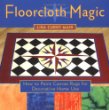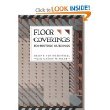Floorcloths
Visit this page on my new website!
👉 18thcenturynotebook.com/floorcloths 👈
Last updated: Oct 20, 2025
John Carwitham’s Various kinds of floor decorations in both plano and perspective (1739) has designs that could have been used on floorcloths.
The London Tradesman (1747) comments on floorcloth-painting:
In the Turner’s Shop we generally meet with Floor-Cloths, painted in Oil Colours, which is performed by a Claſs of Painters who do little elſe. It requires no great Ingenuity, and the Wages of Journeymen is the same as in other Branches of Painting.
Floorcloth painters’ trade cards often feature images of floorcloths, illustrating the sorts of designs that were likely to have been available at the time. These include Joseph Barnes The Hat & Floor Cloth Warehouse By James Cox, Gatfield & Co., B. Philpott, James Theebridge, Thomas Tillinghast, Joseph Weston, and John White.
18th century treatises on painting
Not necessarily about floor cloths in particular, but these books provide instruction on how to paint and other useful techniques. The ability to imitate different sorts of surfaces would have been especially valuable; a 1760 advertisement in the Maryland Gazette for runaway convict servant John Winter describes him as “a very compleate Houſe painter: he can imitate Marble or Mahogany very exactly, and can paint floor Cloths as neat as any imported from Britain.”
- Dictionarium Polygraphicum: Or, The Whole Body of Arts Regularly Digested (1735)
- The Handmaid to the Arts (1757)
- The Handmaid to the Arts (1758)
- The Laboratory; or, School of Arts (1799)
How to clean a floorcloth
- “Having well swept your floor-cloth, wipe it carefully with a flannel, and when all dust and spots are removed, rub it fist with a flannel slightly waxed, and then with a plain dry one. Or washing occasionally with milk, and dry rubbing may suffice without the use of the wax, and the floor-cloth will be less slippery.” (The Universal Cook and City and Country Housekeeper, 1806)
- “The sides of stairs or passages on which are carpets or floor-cloth should be washed with sponge instead of linen or flannel, and the edges will not be soiled. Different sponges should be kept for the above two uses; and these and the brushes should be well washed when done with, and kept in dry places.” (The New London Family Cook, 1808; A New System of Domestic Cookery, 1808)
Possible floorcloths in 19th century images and references
- Floorcloths & fragments from Historic New England, including 1991.1372, 1966.2141, 2003.27.1, 1972.103
- The Sargent family, 1800
- The Woolsey family by William Berczy, 1809
- The artist’s family by George Scharf, 1830
- Portraits attributed to Joseph H. Davis, 1830s: Mary Ann Cook, Lucy Vickery, John Stockbridge Vickery, the Hayes family, the Barrett sisters
- Portraits attributed to Erastus Salisbury Field, including Boy on stenciled carpet (1838), Child holding rattle (1838), Joseph Moore and his family (1839), Margaret Gilmore (1845)
- Floor cloth, and oil cloth covers in An Encyclopedia of Domestic Economy, 1852
- Floor cloth manufacture in Ure’s Dictionary of Arts, Manufacture, and Mines, 1861
- Four drawings showing the manufacture of floor cloth (Met 57.536.3)




